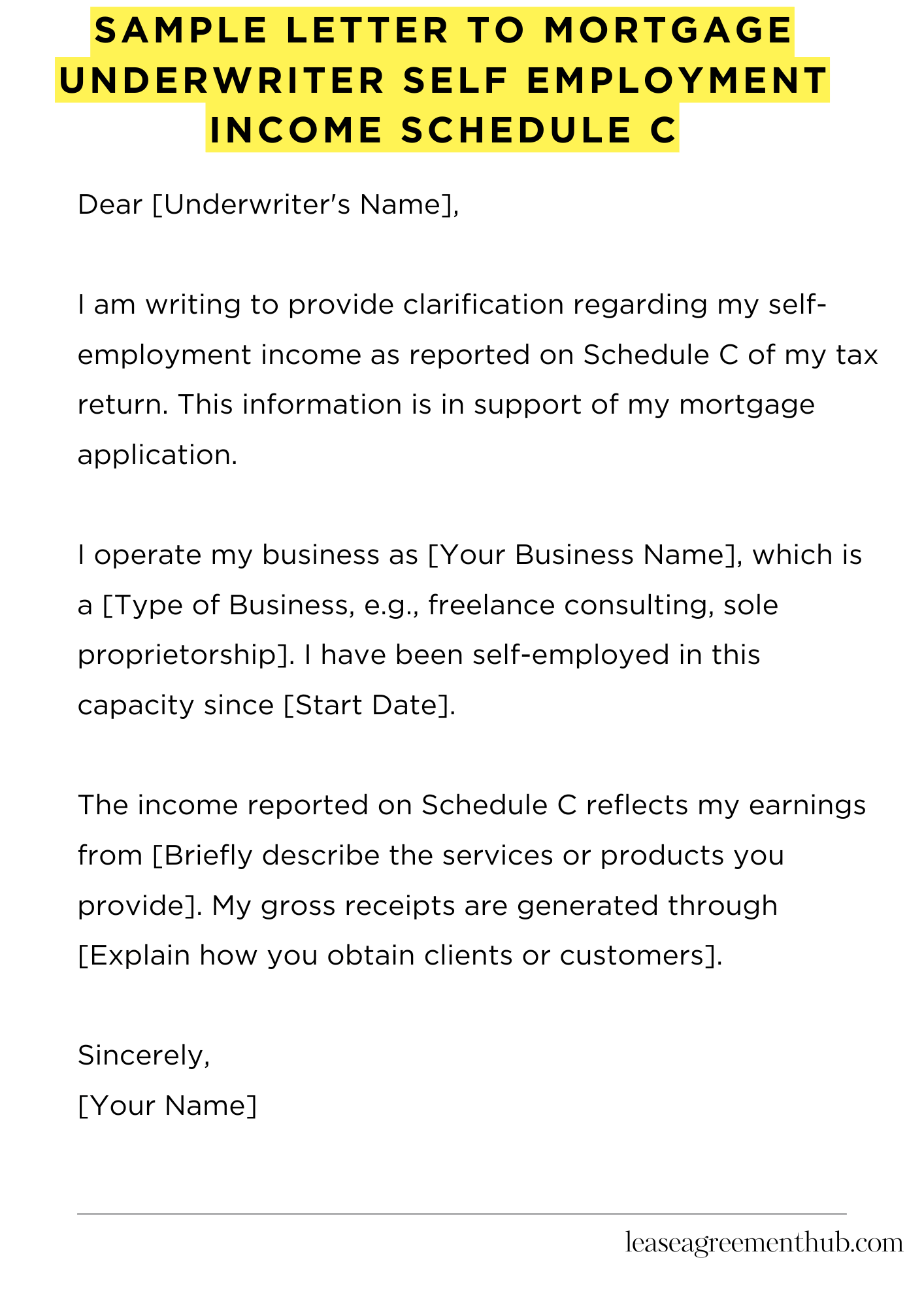Need a mortgage but you’re self-employed? Your Schedule C is key, but underwriters often need more info. A “Sample Letter To Mortgage Underwriter Self Employment Income Schedule C” clarifies your income situation. It explains any inconsistencies or special circumstances.
Writing this letter can feel daunting. Don’t worry, we’ve got your back. We’ll share templates, examples, and samples.
These samples will make writing your letter easy. Get ready to confidently explain your self-employment income. Secure that mortgage!
Sample Letter To Mortgage Underwriter Self Employment Income Schedule C
[Your Name]
[Your Address]
[Your Phone Number]
[Your Email Address]
[Date]
[Underwriter’s Name]
[Underwriter’s Title]
[Mortgage Company Name]
[Mortgage Company Address]
Subject: Explanation of Self-Employment Income – Schedule C
Dear [Underwriter’s Name],
I am writing to provide clarification regarding my self-employment income as reported on Schedule C of my tax return. This information is in support of my mortgage application.
I operate my business as [Your Business Name], which is a [Type of Business, e.g., freelance consulting, sole proprietorship]. I have been self-employed in this capacity since [Start Date].
The income reported on Schedule C reflects my earnings from [Briefly describe the services or products you provide]. My gross receipts are generated through [Explain how you obtain clients or customers].
I understand that underwriters need to assess the stability and reliability of income. To that end, I maintain detailed records of my business income and expenses. I am including [Mention any supporting documents you are including, e.g., profit and loss statements, bank statements].
While my Schedule C reflects certain deductions, these are standard business expenses necessary for the operation of [Your Business Name]. They include [List a few key deductions and briefly explain their purpose, e.g., home office expenses, software subscriptions, marketing costs]. These deductions are consistent year-over-year.
My business has shown consistent [growth/stability] over the past [Number] years, and I anticipate this trend to continue. I am confident in my ability to maintain a stable income stream to meet my mortgage obligations.
Please let me know if you require any further documentation or clarification. I am happy to provide any additional information to support my application.
Thank you for your time and consideration.
Sincerely,
[Your Name]

How to Write Letter To Mortgage Underwriter Self Employment Income Schedule C
Subject Line: Capturing the Essence
- A subject line should be pithy, not protracted. Think: “Schedule C Income Clarification – [Your Name] – [Loan Application Number]”
- Avoid ambiguity. The underwriter should immediately grasp the letter’s purpose.
Salutation: Addressing the Gatekeeper
- Opt for a formal salutation: “Dear [Underwriter’s Name],”
- If the underwriter’s name is elusive, “Dear Underwriting Team,” is acceptable.
- Maintain respect. This is a professional communiqué, not a casual missive.
Introduction: Setting the Stage
- Briefly introduce yourself and reference your loan application.
- State the letter’s objective directly: to elucidate your Schedule C income.
- Example: “I am writing to provide supplementary information regarding my self-employment income as reported on Schedule C, pertinent to loan application number [Loan Application Number].”
Body Paragraph 1: Dissecting the Schedule C
- Articulate the nature of your self-employment. What precisely do you do?
- Highlight the stability and longevity of your business. Underwriters crave consistency.
- Address any significant fluctuations in income. Explain anomalies transparently.
- Provide context. A sudden dip or surge in income warrants a cogent explanation (e.g., a large one-time contract, a temporary market downturn).
Body Paragraph 2: Substantiating Your Claims
- Refer to specific lines on your Schedule C to bolster your explanation.
- For example: “Line 31, Net Profit or (Loss), reflects [Amount] due to [Reason].”
- Offer supporting documentation beyond the Schedule C itself, if applicable (e.g., client contracts, bank statements).
- Quantify your statements. Use tangible numbers to reinforce your narrative.
Addressing Potential Concerns: Proactive Transparency
- Anticipate potential queries the underwriter might harbor.
- For instance, if you claim significant business expenses, justify their necessity.
- Reiterate the legitimacy and sustainability of your self-employment income.
- Proactive disclosure can forestall further inquiries and expedite the approval process.
Closing: Sealing the Deal
- Express gratitude for the underwriter’s time and consideration.
- Reiterate your availability to furnish additional information if needed.
- Use a professional closing: “Sincerely,” or “Best regards,”
- Include your full name, phone number, and email address. Ensure easy accessibility.
Frequently Asked Questions: Sample Letter to Mortgage Underwriter – Self-Employment Income (Schedule C)
This section addresses common inquiries regarding letters to mortgage underwriters that verify self-employment income using Schedule C tax forms. Understanding the key elements of such a letter can significantly aid the mortgage approval process.
What is the primary purpose of a letter to a mortgage underwriter regarding Schedule C income?
The primary purpose is to provide context and clarification regarding your self-employment income as reported on Schedule C, helping the underwriter assess its stability and reliability for mortgage approval.
What key information should be included in the letter?
The letter should include your business name, a summary of your business activity, explanations for any significant income fluctuations, and any supporting documentation that validates your income.
How should I address inconsistencies in my reported Schedule C income?
Address inconsistencies directly by providing clear explanations for any year-over-year variations, such as one-time expenses, economic downturns, or business expansions that impacted your earnings.
Is it necessary to include supporting documentation with the letter?
Yes, including supporting documentation like bank statements, client contracts, or profit and loss statements strengthens your claims and provides the underwriter with tangible evidence of your income.
Who should sign the letter, and what is the preferred method of delivery?
You, as the self-employed individual, should sign the letter. Sending the letter electronically via secure email or uploading it directly to the lender’s portal is generally the preferred delivery method for efficiency and security.
Related: